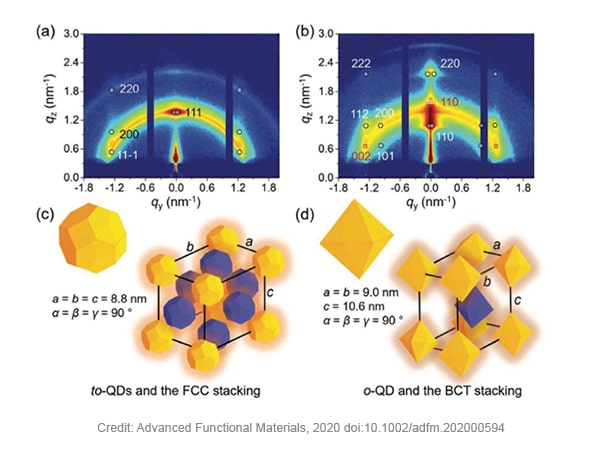GISAXS reveals packing of PbS quantum dots for use in solar cells
Quantum dots are semiconducting nanocrystals of about two to ten nanometers in size. Due to their tunable optoelectronic properties, they find use in a range of applications such as LEDs, single-electron transistors, medical imaging and solar cells. When used in solar cells, light produces an electron-hole pair in the quantum dots, which can be separated by applying an electrochemical potential. The flow of electrons and holes is what creates an electric current.
Lead sulfide (PbS) quantum dots are a promising material for the production of photovoltaic materials as they show high-efficiency, low-cost and high stability in air. The different crystallographic facets that can occur upon different quantum dot synthesis methods have been shown to result in different ligand binding properties, which in turn impacts the occurrence of so called ‘trap states’. These trap states limit the performance of solar cells and passivation of trap states is an important strategy to increase the power conversion efficiency of these devices.
A recent collaboration of the Huazhong University of Science and Technology with the Technical University of Munich, The Southern University of Science and Technology and Shenzhen University resulted in a publication [1] showing that the formation of crystallographic facets of Pbs quantum dots can be controlled by controlling the synthesis of these quantum dots. Under thermodynamic control, they grow mainly to truncated octahedrons (figure c below) with {100} and {111} facets, whereas under kinetic growth regimes octahedrons (figure d below) are prevalent, exhibiting {111} facets only.

Grazing Incidence Small-Angle X-ray Scattering (GISAXS) is an efficient method to detect the difference in shape of these quantum dots because it is sensitive to the packing of the material. The packing of the quantum dots in spin-coated films is determined by the shape, and thus terminating facets, of the particles. Whereas truncated octahedrons pack as spheres, in a face centered cubic (FCC) fashion, the octahedrons stack in a body-centered cubic/tetragonal (BCC/BCT) layout. Calculated Bragg peaks from these superlattice models (indicated with white dots) are in good correspondence with the GISAXS results (figure a and b above). Furthermore, the GISAXS results allows for the calculation of lattice constants.
Several other interesting examples of how GISAXS but also Grazing Incidence Wide-Angle X-ray Scattering (GIWAXS) are successfully used in studying quantum dots can be found in a recent paper referenced below [2]. GISAXS is a surface sensitive technique providing structural information of nanostructured thin films at the nanometer scale (1 – 200 nm) with statistically relevant information due to the X-ray beam footprint. By changing the configuration of measurement of the X-ray scattering instrument, sample parameters at shorter length scales (0.1 – 1 nm) can be probed in GIWAXS measuring mode. In their paper, the authors present various recent examples of measurements on different superlattices structures. They show that GISAXS/GIWAXS are valuable techniques to understand the self-assembly and structure of quantum dots.


